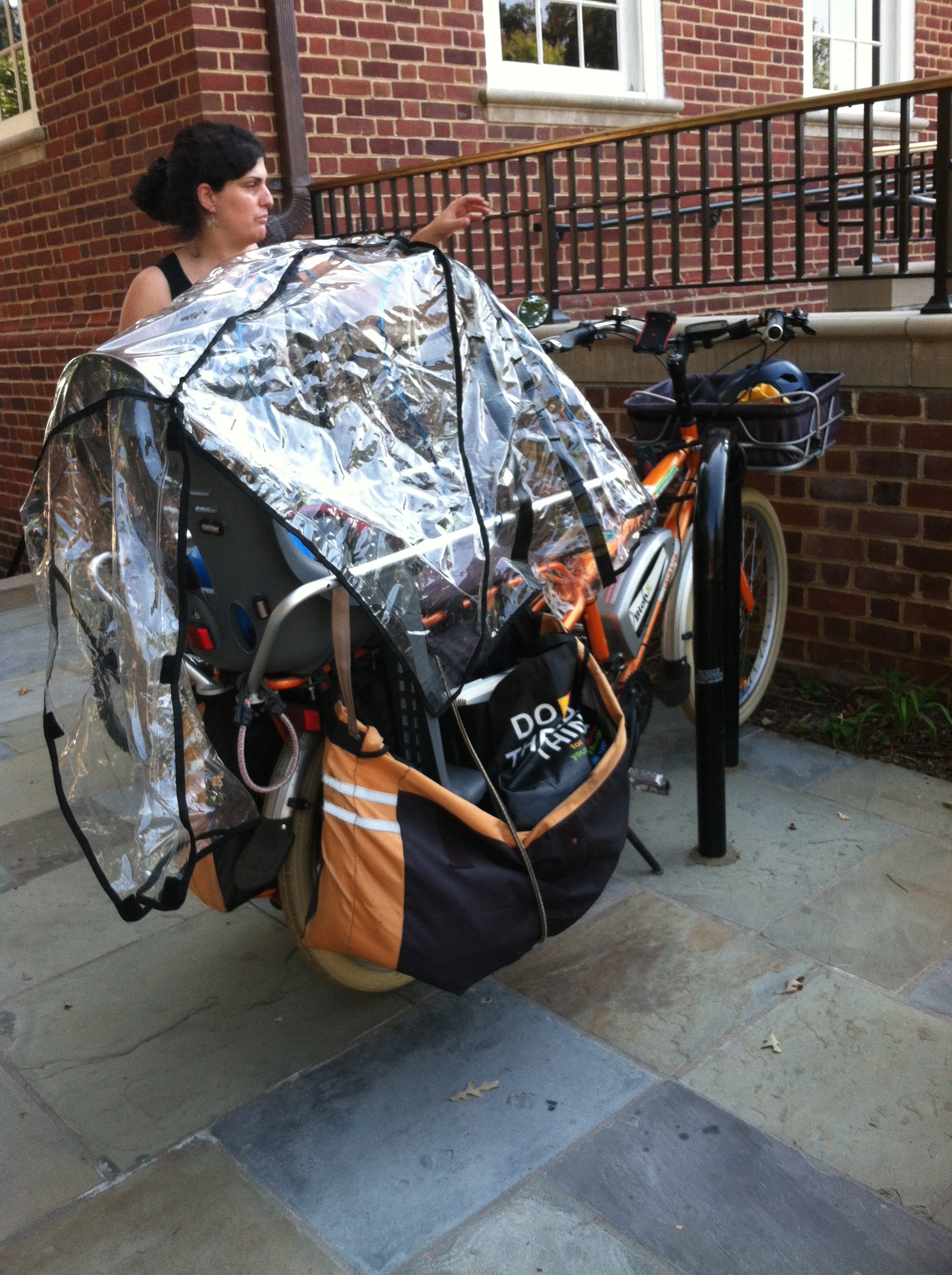As I’ve found out through my Kidical Mass rides, family biking is probably the toughest nut to crack when it comes to encouraging cycling for transportation. All of the usual barriers – being and feeling safe, having enough time to cycle, carrying needed gear – are exaggerated to the nth degree. Then there’s the sheer logistics of carrying kids on a bike, as well as the physical strength needed to drag that extra weight. So I was thrilled that the Washington Area Bicyclists’ Association, as part of their Women and Bikes initiative and promotion of Kidical Mass, held a Family Biking Workshop last weekend. Besides picking up some tips for my own use, I’d like to run a similar workshop for Kidical Mass Rockville in the future.
I was a little surprised when I showed up 10 minutes late and I was the first one there, but we ended up having a small crowd. Before the workshop, I had the chance to meet Megan, my counterpart for the DC Kidical Mass rides. She’s been doing both family riding and Kidical Mass rides much longer than I have, so I was eager to hear her insights. The President of WABA’s board also attended, who I’m sure is quite familiar with biking in general. But judging from the snoozing infant strapped to him in a baby carrier, family biking appeared to be quite new.
In her presentation, Megan ran through the many issues unique to family biking, including equipment, weather, napping and snacking. Both I and the general audience found the equipment section the most helpful. Although we have a trailer, I haven’t been the most satisfied with it. Because he can’t see anything, Sprout doesn’t like it, which eliminates most of the benefits of bringing him on recreational rides. It’s also very isolating for him – he can’t really hear me and once he starts talking, I won’t be able to hear him either. If we have a second kid, we’ll run out of space in the trailer and have to deal with two squirmy kids rather than one.

Megan’s Yuba set-up, complete with rain cover and monkey bars
In contrast, Megan’s set-up appeared to solve my safety issues with bike seats while allowing her kids to enjoy the scenery. It also seemed more convenient than the trailer, which setting up is a multi-step process. She has a Yuba cargo bike fitted out with kid-friendly accessories. She has a bench-style seat for the older kid and a traditional bike seat for the younger one behind it. She had installed “monkey bars,” aluminum railings that encircle the back seat area. Along with providing a place for the older kid to hold on to, they also protect the kids from hitting the ground if the bike tips over. She also provided a perfect solution for my other issue with cargo bikes – that they don’t fit in our shed. Because she lives in an apartment, she stores her bike outside. To protect it from both the weather and prying eyes, she covers it with a motorcycle cover. It was a solution that was absurdly simple, but I would have never considered.
It will still be a couple of years before we switch out the trailer for a cargo bike, but the discussion definitely sparked my imagination. Especially because she said they’ve actually come out with better options since she bought hers, like the Xtracycle Edgerunner, which further minimizes the center-of-gravity issues.
Much of the equipment discussion centered around the options for electric-assist, which interested me a lot less. Because Chris is the main caretaker and not an avid cyclist, I suspect we’re never going to bike for transportation with Sprout enough to make it worth it. Similarly, I think that’s too much of a leap for most suburban families to even mention if I was to do a workshop in Rockville.
Other sections brought up a few different points I had never considered. On a bike, not only do you need to deal with the mess factor for snacking, but also the possibility of the snack gumming up your gears and wheels. Megan recommended Graham crackers as a healthy and safe option. We also discussed what age kids can start riding their own bikes. She recommended kids start on a balance bike between two and three years old. As I was planning on getting Sprout a balance bike for his next birthday, I think that will work out perfectly.
It’s easy to feel unusual for bringing little kids on bikes, even in the cycling advocacy community. So it was great to talk in person to other people sharing some of the same challenges. This was a bit of a test case, so I think the next time around we can attract even more participants. The D.C. area actually has the greatest density of Kidical Mass rides in the country, which in and of itself is quite an accomplishment.
It will take a lot of work to make sure the next generation has access to safe, useful bicycling infrastructure and is educated on how to use it. But engaging them and their parents while they are young is a good start.

